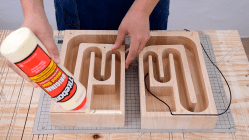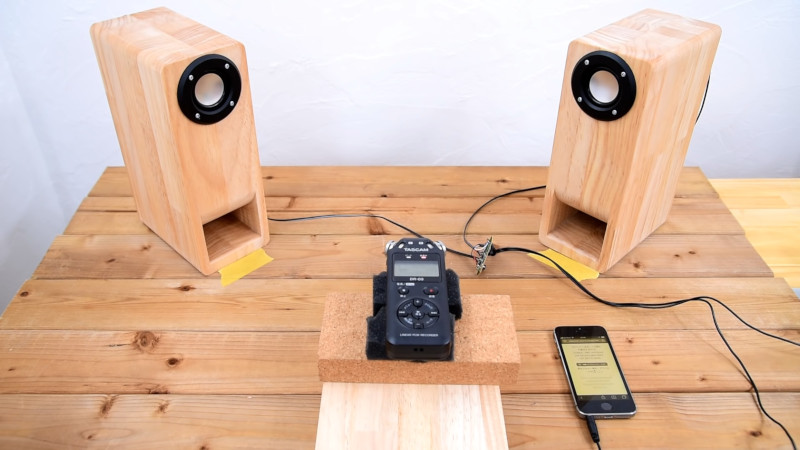It’s possible to pick up a low-cost set of speakers for a few dollars, but by and large, you don’t get a lot of quality for your money. Expect a small pair of drivers, with tinny sound and ugly noises from the enclosure’s cheap materials. [JSK-koubou] has shown us, however, that these speakers can become so much more.

In this case at least, the basic speaker drivers and electronics inside were passable. Harvesting these, the builder then proceeds to create a stunning pair of tuned wooden enclosures for the speakers. This is achieved with a routing template, large blocks of wood and plenty of elbow grease.
The internal structure makes a huge difference to the bass response of the speakers, allowing them to far more faithfully recreate the music under test. Thanks to the artisan-level craftsmanship, the final product is stunning to look at, too. It’s impressive just how well a cheap pair of drivers can perform with a proper enclosure, and of course, there’s nothing to stop an even better set of drivers being installed, either.
When building your own speakers, your creativity is the limit. Video after the break.
















Bass-reflex is a lie.
No. The internal does not improve quality. It merely exchanges one imperfection (high cut-off frequency at the lower end of the spectrum) for another (poor impulse response).
So if you have two speaker. One for low frequency and one for high freauency you can improve the quality of tbe sound on the whole range ?
tweeters and woofers, yes
You can even go way deeper with Thumpers, woofers, mid range, high range and tweeters.
This gives you many ways to cover the full spectrum.
Is Thumper a specific brand name? I have known them as subwoofers for over thirty-five years.
I know this is way old, but for those who come after: a thumper is a tactile bass driver. A subwoofer provides the super deep booming bass you hear; a thumper provides the sounds that are even deeper, where you feel them more than you hear them.
The novelty “4-D” theaters and now gamer chairs have them in the seats to provide that extra vibration element that makes the bass you can hear seem even more powerful.
You can improve with this transmission line shaped internal, but you need to know a lot of specs of the speakers and have to do a lot of calculation. On this website https://www.lautsprechershop.de/index_tools_en.htm you find calculation and eplanation of lots speaker enclosure designs.
https://www.lautsprechershop.de/index_tools_en.htm
The shape of the tunnel doesn’t matter much as its cross section is smaller than the wave length. Only its length and volume matter. A diaphragm of a speaker is a second order system (mass on a spring). Adding an open tunnel behind the speaker means increasing the order of the system (adding another mass and a spring) to decrease the resonant frequency. Yes it actually decreases the resonant frequency, but it also makes the phase characteristics of the system more complicated. Different frequencies travel through the tunnel at different speeds, which means, bass-reflex loudspeaker are worse at reproducing impulses. Bass guitar may sound better if played slowly, a funky one like RHCP won’t. And bass drums will always sound like garbage.
The only way to get a good sound, is to get good speakers and put them in heavy, stiff, air tight boxes.
Most speakers are a compromise. Perfection is an art.
The internal design can make a huge difference in bass response. Failure to place the driver properly or include plenty of fiberglass or similar filler will cause peaks and dips. Poor design — for instance, trying to overextend the low frequency cutoff — will cause poor impulse response, so don’t do that. Frequently, just reducing the LF falloff instead of eliminating it is a good design choice, and the remainder can be recovered with tone controls.
You should think before you make a post. The author did not say the enclosure improved the quality. Rather, he said, “allowing them to far more faithfully recreate the music under test.” In other words, good cabinet design allows the speakers to do what they were intended to do rather than hinder them.
I highly recommend to consider getting good drivers, if you really take the time to make a nice enclosure. Also, the volume and shape of the horn (aka transmission line) needs to be adjusted to the actual driver parameters.
That’s what I was thinking. The project is a huge investment in time and effort, and good quality wood is not cheap. Realistically, these are not quite expensive cheapers that are hampered by having drivers that are the worst dirt-cheap crap a 2-bit company could scrounge up in China.
Just buy good drivers from a reputable source. Of course then you lose the click-bait of “cheap” speakers sounding great…never mind that these are now very expensive speakers and the click-bait is a lie.
What determine the internal geometry of the speaker ? Is the length of the audio conduit the only variable ? Is it matched to desired wavelength or is it a different relation ?
Length and volume. The mass of air in the tunnel must match the characteristics of the speakers. But it won’t do much good (see my posts above).
The Theile–Small parameters of the driver will dictate the best enclosure volume to use for a particular driver. Once you have those, you can calculate other parameters such as driver volume, port diameter and length (if using a bass-reflex design), etc.
What was the drill guide he was using?
Probably custom made. He makes many of his own tools (see his other videos).
If you’re going to use $10 speakers, cut up and glue up some pallets to make the enclosure.
You get what you pay for.,
Are you sure you’re on the right site? There’s got to be something out there with oxygen free gold plated USB cables for you to look at.
Cheap and DIY speaker info with actual science (sub to Tech Ingredients if you haven’t already):
https://www.youtube.com/watch?v=zdkyGDqU7xA
https://www.youtube.com/watch?v=CKIye4RZ-5k
https://www.youtube.com/watch?v=EEh01PX-q9I
Clickbait is so horribly offputting though, I’d rather watch a craftsman over this garbage any day
Yeah except this guy really knows what he is doing and ignores any audiophile crap and goes back to the science basics.
I watch some of his other stuff, presentation is average, but the scientific quality of his info is some of the highest on the web and he is a specialist defence contractor to US military I believe. MD by profession.
A lovely piece of art – but bad speakers in a nice enclosure is the result. All of this equipment used – well I went the other way: buy the Fostex speakers https://www.wilmslowaudio.co.uk/fostex-56-c.asp and the build instructions taken to B&Q, they cut the wood. Does not look as good but beats the sound by a factor of 10. All of his work did deserve a better speaker. By yjr way: the same speakers here in a small bass reflex box size of an A4 sheet 20x30x20 are now replacing my PC speakers. Here it lasted actually the first 6 months trial when I had no glue used – just sticky tape – and now the same still after 7 years … Here I cannot hear any transparency at high frequencies – but a cheap speaker stays a cheap speaker.
Found the details again at https://www.wilmslowaudio.co.uk/fe103en-cabinets-2161-p.asp just a few scews needed on each side – and they sound great.
I deal with electronic “pipe” organs, big bass cabinets for those deep 1st octave sounds. With most designs the 2nd octave will have a big dip in response somewhere. Good organ voicing has to eliminate the dips and peeks of speakers, for note to note even tone level.
I would like to make the speaker system to do whatever the width of smooth response is and then e-xover to the next amp and bass speaker to cover the next range. Perhaps this would be only an octave, still only 3 speakers to do the bass range. The efficiency is higher over all and inter-modulation distortion is less. Most boomy bass cabs have the hole in response, casual listening never shows it. Boom like noise sells!
Totally awesome speakerhack, beautiful video!
If you’re wanting to duplicate how some Bose waveguide speakers work, the ratio is 1:4. The path from the rear of the driver needs to be 4x the length of the tube from the front. Saw that years ago in a magazine article on some then new Bose tower speakers. The article included a picture with a driver with plain straight tubes attached front and rear to illustrate the ratio. Put a 90 degree elbow on the ends of the tubes and fabricate a stand to hold them upright and there’s your “Bose” waveguide.
Anybody know where I can get _decent_ replacement tweeters for my brother’s KLH Three-Thirties?
The speed of sound in air is not dependent on frequency.
No dispersion?